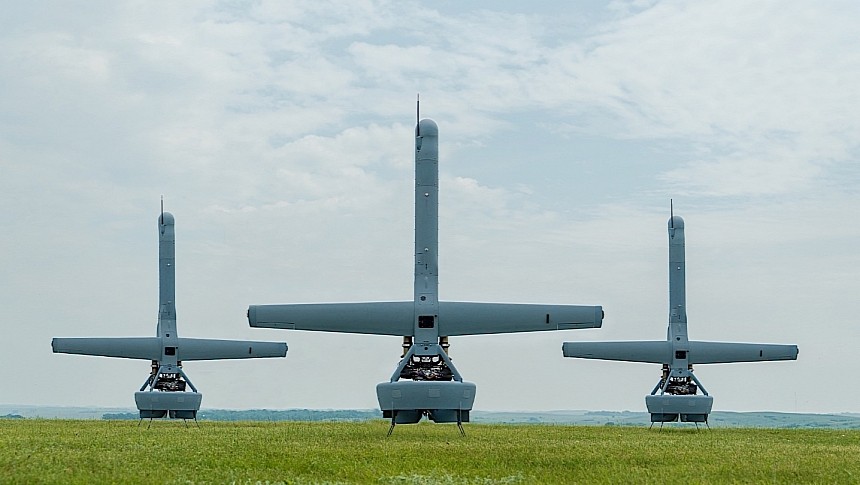You've probably all seen some sci-fi movie where a bunch of alien spacecraft or some other sort of equally alien structure comes down to Earth, ready to get all nasty and mean. Look at the main photo of this piece and tell me these things here look different from that.
"These things here" are actually human-made drones put together by a company called Shield AI. We've heard and talked about these guys before, but not nearly as much as we will, should the plans this company has for the world become reality: placing most (if not all) of America's military vehicles under AI control.
That AI is called Hivemind, and it's being developed as a means to fly, navigate, and control everything in America's military arsenal: aircraft, drones, ships, satellites and submarines.
The system has been designed to work independently from human control, and for that to happen it doesn't even need trivial stuff like communication with a ground station or controller, GPS or previously set waypoints. Exactly how that's done is for now a matter between Shield AI and the military.
We do have a taste of the system's capabilities though. Hivemind was thoroughly put to the test as part of an AFWERX program, whose completion was announced this week.
The AI was used to control and coordinate in an autonomous matter a pack of three V-BAT drones. We've talked about them too at length not long ago, but here's a quick reminder.
The V-BAT is not your typical drone in terms of design. Instead of multiple exposed rotors, or some kind of engine, the machine has a single rotor at the back of the craft, hidden under a protective cover. It also has a body and two wings that, when the craft is resting on the ground, kind of make the whole thing look like some sort of cross monument. Or, at the very least, some sort of alien spacecraft or artifact.
On a technical level, the drone's single rotor, which uses a ducted fan design, provides 80 percent more thrust at equivalent engine power. We don't have any numbers as to exactly what that means, but you have to admit it does sound exotic.
The 9-foot (2.7 meters) long V-BAT can stay in the air for as long as 10 hours and can reach altitudes of up to 20,000 feet (6,000 meters). It can also hover for long periods of time.
During the AFWERX tests concluded recently Shield AI says a trio of such machines were flown in a teaming demonstration. The demo was not military-oriented, but worked under a wildfire scenario, with the drones tasked with monitoring the simulated disaster.
The moment marked another step forward for the V-BAT and its Hivemind to become commonplace in the hands of the American military. Although the systems have been field tested by the U.S. Navy and Marine Corps since 2016, it's only next year that Shield AI expects the machines to get full autonomous capabilities, and open the doors for real-life use.
That AI is called Hivemind, and it's being developed as a means to fly, navigate, and control everything in America's military arsenal: aircraft, drones, ships, satellites and submarines.
The system has been designed to work independently from human control, and for that to happen it doesn't even need trivial stuff like communication with a ground station or controller, GPS or previously set waypoints. Exactly how that's done is for now a matter between Shield AI and the military.
We do have a taste of the system's capabilities though. Hivemind was thoroughly put to the test as part of an AFWERX program, whose completion was announced this week.
The AI was used to control and coordinate in an autonomous matter a pack of three V-BAT drones. We've talked about them too at length not long ago, but here's a quick reminder.
The V-BAT is not your typical drone in terms of design. Instead of multiple exposed rotors, or some kind of engine, the machine has a single rotor at the back of the craft, hidden under a protective cover. It also has a body and two wings that, when the craft is resting on the ground, kind of make the whole thing look like some sort of cross monument. Or, at the very least, some sort of alien spacecraft or artifact.
On a technical level, the drone's single rotor, which uses a ducted fan design, provides 80 percent more thrust at equivalent engine power. We don't have any numbers as to exactly what that means, but you have to admit it does sound exotic.
The 9-foot (2.7 meters) long V-BAT can stay in the air for as long as 10 hours and can reach altitudes of up to 20,000 feet (6,000 meters). It can also hover for long periods of time.
During the AFWERX tests concluded recently Shield AI says a trio of such machines were flown in a teaming demonstration. The demo was not military-oriented, but worked under a wildfire scenario, with the drones tasked with monitoring the simulated disaster.
The moment marked another step forward for the V-BAT and its Hivemind to become commonplace in the hands of the American military. Although the systems have been field tested by the U.S. Navy and Marine Corps since 2016, it's only next year that Shield AI expects the machines to get full autonomous capabilities, and open the doors for real-life use.












